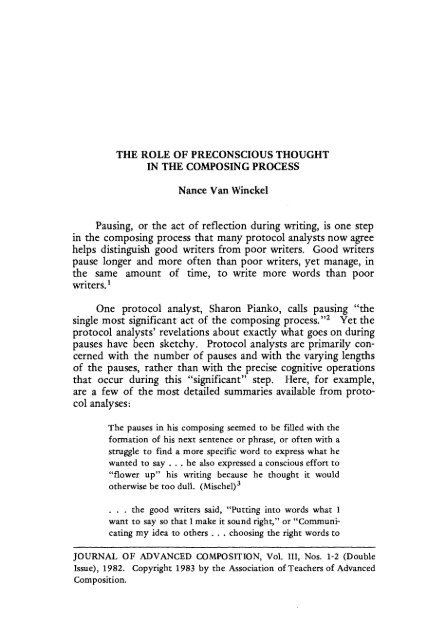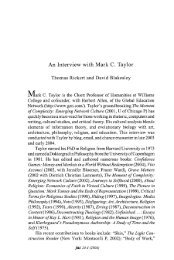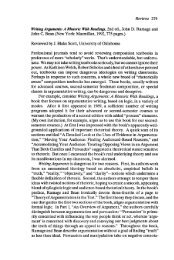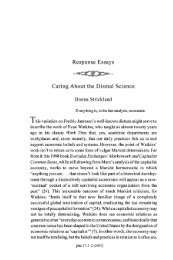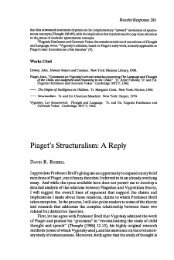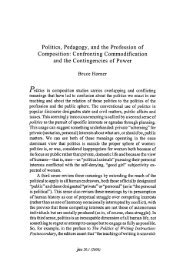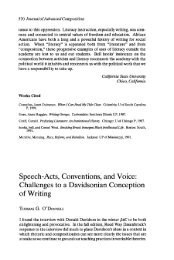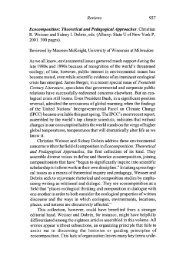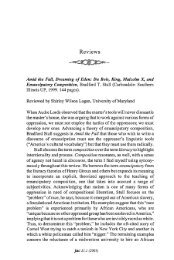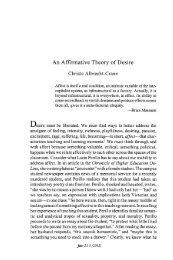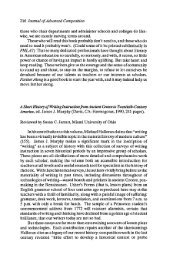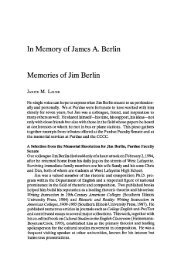Nance Van Winckel Pausing, or the act of reflection ... - JAC Online
Nance Van Winckel Pausing, or the act of reflection ... - JAC Online
Nance Van Winckel Pausing, or the act of reflection ... - JAC Online
You also want an ePaper? Increase the reach of your titles
YUMPU automatically turns print PDFs into web optimized ePapers that Google loves.
THE ROLE OF PRECONSCIOUS THOUGHT<br />
IN THE COMPOSING PROCESS<br />
<strong>Nance</strong> <strong>Van</strong> <strong>Winckel</strong><br />
<strong>Pausing</strong>, <strong>or</strong> <strong>the</strong> <strong>act</strong> <strong>of</strong> <strong>reflection</strong> during writing, is one step<br />
in <strong>the</strong> composing process that many protocol analysts now agree<br />
helps distinguish good writers from po<strong>or</strong> writers. Good writers<br />
pause longer and m<strong>or</strong>e <strong>of</strong>ten than po<strong>or</strong> writers, yet manage, in<br />
<strong>the</strong> same amount <strong>of</strong> time, to write m<strong>or</strong>e w<strong>or</strong>ds than po<strong>or</strong><br />
writers.!<br />
One protocol analyst, Sharon Pianko, calls pausing "<strong>the</strong><br />
single most significant <strong>act</strong> <strong>of</strong> <strong>the</strong> composing process."2 Yet <strong>the</strong><br />
protocol analysts' revelations about ex<strong>act</strong>ly what goes on during<br />
pauses have been sketchy. Protocol analysts are primarily concerned<br />
with <strong>the</strong> number <strong>of</strong> pauses and with <strong>the</strong> varying lengths<br />
<strong>of</strong> <strong>the</strong> pauses, ra<strong>the</strong>r than with <strong>the</strong> precise cognitive operations<br />
that occur during this "significant" step. Here, f<strong>or</strong> example,<br />
are a few <strong>of</strong> <strong>the</strong> most detailed summaries available from protocol<br />
analyses:<br />
The pauses in his composing seemed to be filled with <strong>the</strong><br />
f<strong>or</strong>mation <strong>of</strong> his next sentence <strong>or</strong> phrase, <strong>or</strong> <strong>of</strong>ten with a<br />
struggle to find a m<strong>or</strong>e specific w<strong>or</strong>d to express what he<br />
wanted to say ... he also expressed a conscious eff<strong>or</strong>t to<br />
"flower up" his writing because he thought it would<br />
o<strong>the</strong>rwise be too dull. (Mischel)3<br />
... <strong>the</strong> good writers said, "Putting into w<strong>or</strong>ds what I<br />
want to say so that I make it sound right," <strong>or</strong> "Communicating<br />
my idea to o<strong>the</strong>rs ... choosing <strong>the</strong> right w<strong>or</strong>ds to<br />
JOURNAL OF ADVANCED COMPOSITION, Vol. III, Nos. 1-2 (Double<br />
Issue), 1982. Copyright 1983 by <strong>the</strong> Association <strong>of</strong> Teachers <strong>of</strong> Advanced<br />
Composition.
Nancy <strong>Van</strong> <strong>Winckel</strong><br />
103<br />
communicate with," "getting it on paper." Writers chosen<br />
at random said things like, "Getting my ideas across,"<br />
<strong>or</strong> "Putting what I mean into w<strong>or</strong>ds." (Stallard) 4<br />
Some students explained that <strong>the</strong> great maj<strong>or</strong>ity <strong>of</strong> <strong>the</strong>ir<br />
pauses were f<strong>or</strong> planning ahead-what to write next ....<br />
Some <strong>of</strong> <strong>the</strong> pauses were simply f<strong>or</strong> a "brea<strong>the</strong>r-space."<br />
... But o<strong>the</strong>r students explained that most <strong>of</strong> <strong>the</strong>ir pauses<br />
were f<strong>or</strong> diversions <strong>or</strong> f<strong>or</strong> hoping that <strong>the</strong> c<strong>or</strong>rect spelling,<br />
c<strong>or</strong>rect w<strong>or</strong>d, <strong>or</strong> what to write next would appear to<br />
<strong>the</strong>m. (Pianko)s<br />
Two o<strong>the</strong>r protocol analysts, Linda Flower and John Hayes,<br />
however, have recently outlined a model <strong>of</strong> <strong>the</strong> composing process<br />
that provides a better understanding <strong>of</strong> <strong>the</strong> cognitive <strong>act</strong>ivities<br />
that take place during pauses. Flower and Hayes stress <strong>the</strong><br />
cognitive dynamics <strong>of</strong> composing, explaining that writers must<br />
juggle "a number <strong>of</strong> simultaneous constraints" as <strong>the</strong>y write;<br />
<strong>the</strong>y mention "planning, retrieving inf<strong>or</strong>mation, creating new<br />
ideas, producing language, and revising. . .. also drawing inferences,<br />
creating concepts, developing an image <strong>of</strong> <strong>the</strong> reader,<br />
testing what <strong>the</strong>y've written against that image and so on."6 In<br />
<strong>the</strong>ir December 1981 CCC article, "A Cognitive Process The<strong>or</strong>y<br />
<strong>of</strong> Writing," Flower and Hayes explain that <strong>the</strong> processes <strong>of</strong><br />
generating ideas and evaluating <strong>the</strong> written translation <strong>of</strong> those<br />
ideas into language "appear to have <strong>the</strong> power to interrupt <strong>the</strong><br />
writing process at any· point-and <strong>the</strong>y frequently do;" Flower<br />
and Hayes go on to say that this "allows f<strong>or</strong> a flexible collab<strong>or</strong>ation<br />
among goals, knowledge, and text. 7<br />
Many protocol analysts echo Michael Paull (who is not a<br />
protocol analyst) in describing <strong>the</strong> cognitive processes that take<br />
place during pauses as <strong>the</strong> movement from "sensation (<strong>the</strong> sens<strong>or</strong>y<br />
awareness <strong>of</strong> a given experience) to perception (<strong>the</strong> selecting<br />
<strong>of</strong> certain stimuli from that experience) to concept f<strong>or</strong>mation<br />
(<strong>the</strong> structuring <strong>of</strong> those various selections into a coherent, in<br />
<strong>the</strong> sense <strong>of</strong> communicable, whole)."8 But how, m<strong>or</strong>e specifically,<br />
can we begin to describe <strong>the</strong>se complex mental operations<br />
that occur during pauses?<br />
The brain scientists' rep<strong>or</strong>ts about <strong>the</strong> kinds <strong>of</strong> cognitive<br />
operations· that occur during o<strong>the</strong>r creative tasks have some perti-
104 Journal <strong>of</strong> Advanced Composition<br />
nent parallels to <strong>the</strong> thinking processes that take place during<br />
composing. Here it helps to undersc<strong>or</strong>e <strong>the</strong> c<strong>or</strong>relation between<br />
composing and o<strong>the</strong>r "creative" tasks. As defined, f<strong>or</strong> example,<br />
by brain researchers Steve McCallum and Sharon Glynn, creativity<br />
is "<strong>the</strong> process <strong>of</strong> generating, implementing, and communicating<br />
efficient strategies f<strong>or</strong> acquiring novel, useful inf<strong>or</strong>mation.<br />
"9 This definition would seem to c<strong>or</strong>respond quite closely<br />
with what we expect students to do as <strong>the</strong>y compose.<br />
Keeping in mind, <strong>the</strong>n, this parallel between composing<br />
with language and o<strong>the</strong>r "creative" tasks, let us examine three<br />
such "efficient strategies" <strong>of</strong>ten emphasized by brian scientists<br />
in rep<strong>or</strong>ting on many o<strong>the</strong>r similar creative tasks. And, in <strong>the</strong><br />
following pages, I hope to show how <strong>the</strong>se three <strong>act</strong>ivities, all<br />
functions <strong>of</strong> preconscious thought,> undoubtedly account f<strong>or</strong><br />
much <strong>of</strong> <strong>the</strong> time spent pausing during writing.<br />
FOCUSING<br />
The ability to focus on <strong>the</strong> writing task at hand can be<br />
both an asset and a liability. About <strong>the</strong> imp<strong>or</strong>tance <strong>of</strong> initially<br />
narrowing one's writing topic, Lee Odell says, "To respond to<br />
any phenomenon, we have to segment <strong>the</strong> continuum <strong>of</strong> phenomena.<br />
" He compares this process to a camera zooming in to<br />
let us see a char<strong>act</strong>er in relation to what surrounds him. What<br />
matters, though, is keeping <strong>the</strong> char<strong>act</strong>er as our center; thus,<br />
what becomes significant through <strong>the</strong> camera's eye is how <strong>the</strong><br />
char<strong>act</strong>er is affected by <strong>or</strong> affects his surroundings. 1 0 Similarly,<br />
<strong>the</strong> writer must examine his ideas f<strong>or</strong> writing with some "center"<br />
in mind, some subject <strong>of</strong> focus.<br />
Focusing, as Odell goes on to point out, does not always<br />
mean conscious thought. Recent studies by creativity researchers<br />
W. J. J. G<strong>or</strong>don and Tony Poze on <strong>the</strong> interdependent roles <strong>of</strong><br />
conscious, preconscious, and subconscious thought supp<strong>or</strong>t this<br />
assertion. In one <strong>of</strong> <strong>the</strong> most significant articles to date on <strong>the</strong><br />
cognitive dynamics <strong>of</strong> creative thought, G<strong>or</strong>don and Poze outline<br />
<strong>the</strong> following process <strong>of</strong> making a metaph<strong>or</strong>. First a verbal description<br />
<strong>of</strong> <strong>the</strong> subject at hand is reduced to "one functional<br />
essence. " This is entirely a left brain <strong>or</strong> conscious task. The<br />
parallels between left brain and consciousness and right brain
<strong>Nance</strong> <strong>Van</strong> <strong>Winckel</strong> 105<br />
and subconsciousness are made by G<strong>or</strong>don and Poze <strong>the</strong>mselves<br />
in this article. Preconsciousness <strong>the</strong>y see largely in terms <strong>of</strong><br />
thought that observes both w<strong>or</strong>ds and images coming toge<strong>the</strong>r,<br />
<strong>the</strong> place where shutding between left and right brains occurs,<br />
where communication between consciousness and subconsciousness<br />
is most possible. (See W. J. J. G<strong>or</strong>don and Tony Poze,<br />
"Conscious/Subconscious Inter<strong>act</strong>ion in a Creative Act," The<br />
Journal <strong>of</strong> Creative Behavi<strong>or</strong>, 15 (First Quarterly, 1981.) The<br />
second step is to establish a nonverbal image <strong>of</strong> that functional<br />
(verbal) essence-a movement from left to right brain, involving<br />
preconscious thought. Next <strong>the</strong> right brain takes over. It transf<strong>or</strong>ms<br />
<strong>the</strong> nonverbal image into one that's different but similar.<br />
The fourth step is linking that image to a name, <strong>or</strong>, a passing<br />
through preconsciousness again, moving back from right to left<br />
brain. The last step belongs to <strong>the</strong> verbal analyzer, <strong>the</strong> left<br />
brain, which compares <strong>the</strong> new image to <strong>the</strong> <strong>or</strong>iginal to determine<br />
<strong>the</strong> quality <strong>of</strong> <strong>the</strong> fit.11 F<strong>or</strong> example, if one were asked<br />
to make a metaph<strong>or</strong> f<strong>or</strong> a new moon, he <strong>or</strong> she would probably<br />
begin by imagining a visual image <strong>of</strong> <strong>the</strong> sliver <strong>of</strong> yellow moon.<br />
This functional essence would <strong>the</strong>n be transf<strong>or</strong>med into a similar<br />
image, something else that is slighdy wedge-shaped and yellowish.<br />
After a new visualization emerges, say an image <strong>of</strong> a lemon<br />
slice, it moves to <strong>the</strong> left brain and in so doing, receives a name<br />
"lemon slice." Finally, <strong>the</strong> left brain analyzes this new image to<br />
see how well it resembles <strong>the</strong> <strong>or</strong>iginal subject.<br />
These five steps involve both a deliberate and conscious<br />
focusing and an equally deliberate and conscious unfocusing, a<br />
purposeful employment <strong>of</strong> ambiguity, which I will soon look at<br />
in greater depth. Focusing, we can conclude, becomes a liability<br />
when one cannot unfocus, when one holds so tighdy to <strong>the</strong> <strong>or</strong>iginal<br />
subject that it cannot blur, that it cannot become an "o<strong>the</strong>r"<br />
capable <strong>of</strong> generating m<strong>or</strong>e <strong>or</strong>iginal, emotive, <strong>or</strong> insightful ideas.<br />
This recursiveness <strong>of</strong> thinking, <strong>or</strong> <strong>the</strong> "shutding" between<br />
consciousness and subconsciousness which occurs frequendy<br />
during composing, may no doubt account f<strong>or</strong> <strong>the</strong> <strong>of</strong>ten heard<br />
comment that Stallard mentions: "I'm trying to find <strong>the</strong> right<br />
w<strong>or</strong>ds to fit this idea." The emergence <strong>of</strong> subconscious w<strong>or</strong>dless<br />
ideas through preconsciousness to consciousness defines in a<br />
sense <strong>the</strong> way one discovers meaning-by naming <strong>or</strong> by trying to<br />
name one's thoughts.
106 Journal <strong>of</strong> Advanced Composition<br />
The steady movement between conscious verbal thought<br />
and subconscious w<strong>or</strong>dless thought might be analogized to a<br />
child's see-saw. Successful composing might <strong>the</strong>n be equated<br />
with <strong>the</strong> establishment <strong>of</strong> some kind <strong>of</strong> balance between those<br />
two kinds <strong>of</strong> thinking; and <strong>the</strong> fulcrum <strong>or</strong> point <strong>of</strong> stability<br />
might be equated with preconscious thought, <strong>the</strong> mediat<strong>or</strong> between<br />
consciousness and subconsciousness. And, as on <strong>the</strong><br />
see-saw, <strong>the</strong> closer to <strong>the</strong> center (preconsciousness) one remains,<br />
<strong>the</strong> m<strong>or</strong>e easily <strong>the</strong> see-saw maintains a balance, an equilibrium.<br />
John Gazzaniga, a brain researcher, speaks <strong>of</strong> preconsciousness<br />
as <strong>the</strong> place where hemispheral "cross-talk" occurs, where we<br />
can, in a sense, pause in <strong>the</strong> midst <strong>of</strong> both left and right brain<br />
"conversations."I 2 What may also be imp<strong>or</strong>tant about this<br />
analogy is that both left and right brains are joined through that<br />
middle point. They are connected.<br />
Ano<strong>the</strong>r aspect <strong>of</strong> focusing that would appear to jeopardize<br />
<strong>the</strong> kind <strong>of</strong> balance I've just mentioned is <strong>the</strong> "trying too hard"<br />
syndrome. This common beginning writers' problem has two<br />
probable sources. One, a kind <strong>of</strong> exaggeration <strong>of</strong> <strong>the</strong> "I'm trying<br />
to find <strong>the</strong> right w<strong>or</strong>ds to fit this idea," occurs when students<br />
prematurely insist on labeling that subconscious w<strong>or</strong>dless image<br />
as it tries to make its way into consciousness. Instead <strong>of</strong> allowing<br />
<strong>the</strong> thought to reveal itself fully enough to "earn" a label,<br />
<strong>the</strong>y rush to fit it to w<strong>or</strong>ds. The second source <strong>of</strong> trouble is <strong>the</strong><br />
flip-side <strong>of</strong> <strong>the</strong> first. It may be attributed to trying too hard to<br />
hold on to <strong>the</strong> <strong>or</strong>iginal idea in consciousness, that is, trying to<br />
depend on logical, analytic methods <strong>of</strong> examining it; those methods<br />
students <strong>of</strong>ten recognize f<strong>or</strong> <strong>the</strong>mselves are uninteresting,<br />
un<strong>or</strong>iginal, unmotivating, and frustrate <strong>the</strong>ir "getting on" with<br />
<strong>the</strong> paper. Both <strong>of</strong> <strong>the</strong>se problems disturb <strong>the</strong> cognitive balance,<br />
both weighing down heavily on <strong>the</strong> left brain, on consciousness.<br />
It would be an oversight not to look also, though briefly,<br />
at <strong>the</strong> inability to focus. Why are so many beginning writers<br />
unable to keep <strong>the</strong>ir writing subjects in view? Problems may<br />
arise from po<strong>or</strong> motivation, lack <strong>of</strong> knowledge, <strong>or</strong> <strong>the</strong> presence<br />
<strong>of</strong> extraneous emotional concerns. This kind <strong>of</strong> unfocusing,<br />
<strong>the</strong>n, does not seem entirely a cognitive dysfunction. If, on <strong>the</strong><br />
o<strong>the</strong>r hand, <strong>the</strong> writer is focusing on some subconscious image,<br />
he <strong>or</strong> she may occasionally become carried away by a succession<br />
<strong>of</strong> images, which eventually become fantasies. At this point, <strong>the</strong>
<strong>Nance</strong> <strong>Van</strong> <strong>Winckel</strong> 107<br />
writer would ra<strong>the</strong>r not go back to a conscious focus on <strong>the</strong> writing<br />
task's subject. These two problems also indicate <strong>the</strong> need<br />
f<strong>or</strong> a better balance between relaxation and attention.<br />
AMBIGUITY<br />
Generating ideas <strong>or</strong> inf<strong>or</strong>mation f<strong>or</strong> <strong>the</strong> wrmng task depends,<br />
in part, on unfocusing <strong>or</strong> deliberately bringing about ambiguity.<br />
J. P. Guilf<strong>or</strong>d was among <strong>the</strong> first to stress <strong>the</strong> so-called<br />
"creative person's" higher tolerance f<strong>or</strong> ambiguity, a willingness<br />
to remain suspended in a chaos <strong>of</strong> w<strong>or</strong>dless thoughts and images.<br />
O<strong>the</strong>r studies in cognition have concluded that those less comf<strong>or</strong>table<br />
with mental chaos are apt to choose one image very<br />
quickly, perhaps too quickly, from <strong>the</strong> confusion <strong>of</strong> images and<br />
to begin at once to w<strong>or</strong>k consciously-moving back to <strong>the</strong> analytic<br />
left brain-to make that image w<strong>or</strong>k. This concept, part <strong>of</strong><br />
<strong>the</strong> larger <strong>the</strong><strong>or</strong>y <strong>of</strong> cognitive dissonance, holds that such people<br />
depend largely on processes <strong>of</strong> logic and reason to f<strong>or</strong>ce certain<br />
images and ideas into m<strong>or</strong>e effective verbal constructs. And,<br />
though <strong>the</strong>se constructs are <strong>of</strong>ten effective, researchers in creative<br />
thinking are quick to point out that <strong>the</strong> longer one is able<br />
to tolerate cognitive chaos, <strong>the</strong> better one's chances f<strong>or</strong> initially<br />
choosing a m<strong>or</strong>e easily w<strong>or</strong>kable and interesting image <strong>or</strong> idea to<br />
contribute to <strong>the</strong> task at hand. Or, as G<strong>or</strong>don succinctly puts<br />
it, "Ultimate solution to problems are rational; <strong>the</strong> process <strong>of</strong><br />
finding <strong>the</strong>m is not." 1 3<br />
Remaining in a state <strong>of</strong> ambiguity where indistinct images<br />
and w<strong>or</strong>dless thoughts proliferate may again be likened to remaining<br />
at that fulcrum between left and right brains, between<br />
consciousness and subconsciousness. Seeing this point <strong>of</strong> balance<br />
between left and right brains as a fulcrum helps us to understand<br />
what brain scientists think occurs in preconsciousness. Lawrence<br />
Kubie asserted <strong>the</strong> imp<strong>or</strong>tance <strong>of</strong> preconscious processes f<strong>or</strong> creative<br />
thought several years ago. He believed preconsciousness to<br />
be that place between logical and a-logical thinking where ideas<br />
were reshuffled, compared, and amalgamated in <strong>or</strong>iginal ways:<br />
In <strong>the</strong> preconscious use <strong>of</strong> imagery and alleg<strong>or</strong>y many experiences<br />
are condensed into a single hieroglyph, which<br />
expresses in one symbol far m<strong>or</strong>e than one can say slowly
108 Journal <strong>of</strong> Advanced Composition<br />
and precisely, w<strong>or</strong>d by w<strong>or</strong>d, on <strong>the</strong> fully conscious<br />
level. 14<br />
The ability to bring about ambiguity intentionally is also<br />
one on which G<strong>or</strong>don and his synectic think-tank associates at<br />
Harvard rely heavily. G<strong>or</strong>don points out that "extreme f<strong>or</strong>mlessness<br />
immediately precedes <strong>the</strong> emergence <strong>of</strong> <strong>the</strong> [new<br />
image] ."15 But what does this have to do with <strong>the</strong> composing<br />
process <strong>or</strong> with pauses in particular? The answer seems obvious.<br />
A break in such a consciousness-demanding <strong>act</strong>ivity as putting<br />
w<strong>or</strong>ds on paper indicates that purely conscious thought is taking<br />
a "time-out." This may help to explain what many call taking<br />
a "brea<strong>the</strong>r," a time to instigate, intentionally <strong>or</strong> unintentionally,<br />
preconscious thought, to unfocus so as to better accommodate<br />
refocusing.<br />
MEMORY<br />
The deliberate ambiguity-making processes <strong>of</strong> preconscious<br />
thought also occur as a necessary prerequisite f<strong>or</strong> successful<br />
mem<strong>or</strong>y scans. And mem<strong>or</strong>y scanning is, <strong>of</strong> course, a necessity<br />
in generating ideas and inf<strong>or</strong>mation f<strong>or</strong> writing. Says Charles<br />
Stallard:<br />
[The writer begins with a search <strong>of</strong>] his st<strong>or</strong>ehouse <strong>of</strong><br />
knowledge, concepts, attitudes and beliefs, selecting those<br />
that have <strong>the</strong> potential to contribute to <strong>the</strong> topic area <strong>of</strong><br />
his message. . .. The initial search <strong>of</strong> cognitive structure<br />
promotes a chain <strong>of</strong> events. The result is a series <strong>of</strong><br />
searches, each going deeper and becoming m<strong>or</strong>e th<strong>or</strong>oughly<br />
exhaustive <strong>of</strong> <strong>the</strong> potential within <strong>the</strong> changing cognitive<br />
structure. 1 6<br />
Many researchers have come to believe that successful cognitive<br />
searches must employ effective search models. In <strong>the</strong> left<br />
brain, search models are believed to be primarily verbal, since <strong>the</strong><br />
inf<strong>or</strong>mation st<strong>or</strong>ed <strong>the</strong>re is verbal. Our conscious search models<br />
help us find <strong>the</strong> right w<strong>or</strong>ds, remember grammatical rules, and<br />
arrange synt<strong>act</strong>ical units. But because <strong>the</strong> right brain is primarily<br />
non-verbal, <strong>the</strong> search model employed <strong>the</strong>re must also be nonverbal.<br />
G<strong>or</strong>don explains that <strong>the</strong> subconscious, <strong>or</strong> right brain,
<strong>Nance</strong> <strong>Van</strong> <strong>Winckel</strong> 109<br />
contrary to what brain scientists earlier believed, operates, like<br />
<strong>the</strong> left brain, as an analyzer. But it analyzes differently. "It<br />
analyzes on <strong>the</strong> basis <strong>of</strong> imagery because it is dealing with so<br />
many potential bits <strong>of</strong> inf<strong>or</strong>mation that it can only <strong>or</strong>ganize by<br />
f<strong>or</strong>ming images. . .. You can't evoke creative subconscious<br />
<strong>act</strong>ivity unless conscious verbal thinking is converted into an<br />
image," and due to <strong>the</strong> impressionistic nature <strong>of</strong> <strong>the</strong> blurred<br />
image, G<strong>or</strong>don and Poze point out, <strong>the</strong> search model "has m<strong>or</strong>e<br />
analogical potential than a clear precise one. "17<br />
But again, establishing that balance between conscious and<br />
subconscious thought is imp<strong>or</strong>tant in <strong>act</strong>ivating such imagistic<br />
search models. One must be, acc<strong>or</strong>ding to G<strong>or</strong>don and Poze, "in<br />
charge <strong>of</strong> supp<strong>or</strong>ting subconscious <strong>act</strong>ivity which develops a<br />
visual, metaph<strong>or</strong>ical haze and transf<strong>or</strong>ms [<strong>the</strong>] previously precise<br />
image. If <strong>the</strong> image had been kept perfectly int<strong>act</strong>, it would<br />
not have been <strong>the</strong> basis f<strong>or</strong> successful scanning in <strong>the</strong> subconscious<br />
because nothing could have been found except ano<strong>the</strong>r<br />
image [that was ex<strong>act</strong>ly <strong>the</strong> same] ."1 8 This means <strong>the</strong> writer<br />
must be on guard against possible conscious interruption <strong>of</strong> <strong>the</strong><br />
subconscious mem<strong>or</strong>y scan, in which case <strong>the</strong> non-verbal search<br />
model will probably be lost.<br />
We may briefly summarize what may also account f<strong>or</strong><br />
pauses in <strong>the</strong> writing process, <strong>the</strong>n, as breaks in purely conscious<br />
thought that allow <strong>the</strong> writer to construct images in preconsciousness,<br />
and <strong>the</strong>n to employ those images in subconsciousness,<br />
where <strong>the</strong>y become even fuzzier, as search models f<strong>or</strong> new inf<strong>or</strong>mation.<br />
Such imagistic search models, as Guilf<strong>or</strong>d explains,<br />
make it possible f<strong>or</strong> us to retrieve inf<strong>or</strong>mation "aside from responding<br />
to only those cues with which it was learned."1 9 But<br />
<strong>the</strong> right brain search model is by nature fairly unpredictable,<br />
since, as <strong>the</strong> image blurs and becomes increasingly f<strong>or</strong>mless,<br />
"feelings and empathy replace <strong>the</strong> visual image."2 0<br />
The unpredictability <strong>of</strong> what <strong>the</strong> search model will find can<br />
be frustrating as well as rewarding. Much would seem to depend,<br />
as mentioned earlier, on one's patience. But also imp<strong>or</strong>tantly,<br />
much depends on how flexibly inf<strong>or</strong>mation was <strong>or</strong>iginally classified<br />
and st<strong>or</strong>ed, that is, how easily <strong>the</strong> search model can discover<br />
useful inf<strong>or</strong>mation in several neural st<strong>or</strong>age sites. Encoding flexibility<br />
means great decoding flexibility, and consequently an in-
110 Journal <strong>of</strong> Advanced Composition<br />
crease in <strong>the</strong> odds f<strong>or</strong> discovering inf<strong>or</strong>mation with fewer<br />
scanning attempts.<br />
M<strong>or</strong>eover, pausing may result from <strong>the</strong> failure <strong>of</strong> sh<strong>or</strong>tterm<br />
mem<strong>or</strong>y, which is generally thought to involve primarily<br />
verbal, conscious thought processes. As Colette Daiute points<br />
out, "Because so much is going on in mem<strong>or</strong>y during writing, and<br />
since writing is slower than speaking <strong>or</strong> reading, <strong>the</strong> recoding<br />
units may be smaller than during <strong>the</strong> o<strong>the</strong>r language behavi<strong>or</strong>s."21<br />
Similarly, Charles Britton remarks:<br />
What has just been written, and what is still to be written,<br />
can only be held in <strong>the</strong> sh<strong>or</strong>t-term mem<strong>or</strong>y to a very limited<br />
extent. F<strong>or</strong> someone just learning to write, <strong>the</strong> number<br />
<strong>of</strong> w<strong>or</strong>ds in <strong>the</strong> sh<strong>or</strong>t-term mem<strong>or</strong>y may be even<br />
fewer. . .. If ... <strong>the</strong> teasing out <strong>of</strong> <strong>the</strong> thought becomes<br />
particularly difficult, all <strong>the</strong> resources <strong>of</strong> <strong>the</strong> sh<strong>or</strong>t-term<br />
mem<strong>or</strong>y may have to be concentrated on a few w<strong>or</strong>ds.<br />
That is when a writer may lose track <strong>of</strong> his thoughts,<br />
omit, <strong>or</strong> repeat w<strong>or</strong>ds, misconnect <strong>or</strong> blunder in some<br />
way.22<br />
Even good writers, however, experience <strong>the</strong> frustration <strong>of</strong> beginning<br />
to write a well thought-out sentence and f<strong>or</strong>getting <strong>the</strong><br />
middle <strong>or</strong> end <strong>of</strong> it. The sh<strong>or</strong>t-term mem<strong>or</strong>y can hold only a<br />
small amount <strong>of</strong> inf<strong>or</strong>mation at anyone time, and thus may have<br />
to depend on reconsciousness as a kind <strong>of</strong> reposit<strong>or</strong>y f<strong>or</strong> inf<strong>or</strong>mation<br />
retrieved from subconsciousness but not sent on to <strong>the</strong> conscious<br />
sh<strong>or</strong>t-term mem<strong>or</strong>y f<strong>or</strong> verbal processing.<br />
Focusing, <strong>the</strong> purposeful employment <strong>of</strong> ambiguity, and<br />
successful mem<strong>or</strong>y searches all seem to depend, <strong>the</strong>n, on a kind<br />
<strong>of</strong> rhythmic movement between consciousness, preconsciousness,<br />
and subconsciousness. This idea has been suggested bef<strong>or</strong>e,<br />
though with a much different emphasis. Ross Winterowd was<br />
among <strong>the</strong> first to claim that "<strong>the</strong> fluent writer is a hemisphere<br />
hopper."23 But <strong>the</strong> kind <strong>of</strong> rhythm <strong>of</strong> which I'm speaking is<br />
not so much a matter <strong>of</strong> moving back and f<strong>or</strong>th between brain<br />
hemispheres, as an ability to stay in between, to remain in a kind<br />
<strong>of</strong> "holding pattern" where <strong>the</strong> cross talk <strong>of</strong> both conscious and<br />
subconscious thought can be overheard. Preconsciousness is that
<strong>Nance</strong> <strong>Van</strong> <strong>Winckel</strong> 111<br />
state <strong>of</strong> remaining in between. It is no doubt because we can<br />
remain at this kind <strong>of</strong> equilibrium that we are able, as Flower and<br />
Hayes say, to "juggle" those complex constraints writing demands.<br />
And perhaps we may even discover fur<strong>the</strong>r that <strong>the</strong> better<br />
one's balance in this sense, <strong>the</strong> m<strong>or</strong>e constraints one can juggle,<br />
and <strong>the</strong> m<strong>or</strong>e smoothly.<br />
This <strong>the</strong><strong>or</strong>y <strong>of</strong> preconsciousness as <strong>the</strong> balance point between<br />
<strong>the</strong> brains-<strong>the</strong> kind <strong>of</strong> thinking I'm suggesting accounts<br />
f<strong>or</strong> much <strong>of</strong> <strong>the</strong> time spent pausing-differs from earlier <strong>the</strong><strong>or</strong>ies<br />
<strong>of</strong> brain hemispheric functions during composing. Until recently<br />
it was assumed that we simply needed to teach students, if such<br />
a thing is possible, to w<strong>or</strong>k m<strong>or</strong>e in one brain <strong>or</strong> <strong>the</strong> o<strong>the</strong>r. This<br />
notion was based on <strong>the</strong> belief that we simply leap from one<br />
brain to <strong>the</strong> o<strong>the</strong>r as we compose. Much <strong>of</strong> this mistaken emphasis<br />
on brain lateralization <strong>of</strong> "hemisphericity" may be explained<br />
as <strong>the</strong> result <strong>of</strong> <strong>the</strong> nature <strong>of</strong> early brain research. Since<br />
most <strong>of</strong> those early experiments were perf<strong>or</strong>med exclusively on<br />
patients who had had one hemisphere <strong>or</strong> <strong>the</strong> o<strong>the</strong>r removed, <strong>or</strong><br />
had had <strong>the</strong>m surgically separated, naturally one brain hemisphere<br />
<strong>or</strong> <strong>the</strong> o<strong>the</strong>r could be shown to "dominate."<br />
The confluence <strong>of</strong> left and right brain thinking that researchers<br />
now believe occurs in preconsciousness is, I think, a<br />
subject that deserves and is receiving closer scrutiny, and such researchers'<br />
findings may soon give us m<strong>or</strong>e explicit inf<strong>or</strong>mation<br />
about what <strong>act</strong>ually goes on as a writer pauses.<br />
It is most helpful, too, to understand this idea <strong>of</strong> one's<br />
"thinking" rhythm in <strong>the</strong> larger context <strong>of</strong> one's "thinkingwriting"<br />
rhythm. Sondra Perl concludes in one protocol study,<br />
f<strong>or</strong> instance, that students' over-concern f<strong>or</strong> c<strong>or</strong>rect w<strong>or</strong>king and<br />
mechanics "interrupts so <strong>of</strong>ten and to such a degree that it<br />
breaks down <strong>the</strong> rhythm generated by writing. When this happens,<br />
students are f<strong>or</strong>ced to go back and recapture <strong>the</strong> strands <strong>of</strong><br />
<strong>the</strong>ir thinking once <strong>the</strong> editing operation has been completed."2 4<br />
Such a premature concern f<strong>or</strong> editing, <strong>the</strong>n, seems to undermine<br />
a student's ability to remain focused on what he <strong>or</strong> she is trying<br />
to write, which undoubtedly accounts f<strong>or</strong> many beginning<br />
student writers' frustrations with writing.<br />
This thinking-writing rhythm, though naturally not <strong>the</strong>
112 Journal <strong>of</strong> Advanced Composition<br />
same f<strong>or</strong> all writers, is one writers acquire with pr<strong>act</strong>ice and<br />
gradually internalize. That is, by experiencing it <strong>of</strong>ten enough,<br />
<strong>the</strong>y know what it feels like to slip into it, and are <strong>the</strong>n better<br />
able to aim f<strong>or</strong> it deliberately as a way <strong>of</strong> m<strong>or</strong>e easily facilitiating<br />
effective writing. Many good writers, maybe even writing<br />
teachers, undoubtedly take <strong>the</strong>ir own composing rhythms f<strong>or</strong><br />
granted and, consequently, may not realize that developing<br />
writers have yet to understand how to find a balance between<br />
such diverse tasks as generating ideas and assessing <strong>the</strong>ir relevance,<br />
between holding ideas in one's mem<strong>or</strong>y and translating<br />
and rec<strong>or</strong>ding <strong>the</strong>m into verbal constructs, and between thinking<br />
ahead to new strategies while at <strong>the</strong> same time remembering<br />
what has gone bef<strong>or</strong>e, and writing itself. Pauses, in sh<strong>or</strong>t, indicate<br />
<strong>the</strong> balance upon which <strong>the</strong> rhythm rests has tilted, and all<br />
<strong>the</strong> energies have shifted toward thinking.<br />
It also seems reasonable to assume why-if much <strong>of</strong> <strong>the</strong><br />
thinking that goes on in pauses is not "conscious"-students are<br />
unable to verbalize to protocol analysts ex<strong>act</strong>ly what has been<br />
going through <strong>the</strong>ir minds in <strong>the</strong>se pauses. As mentioned bef<strong>or</strong>e,<br />
subconscious and preconscious thought do not rely primarily<br />
on verbal symbols. Theref<strong>or</strong>e, protocol analysis does seem to<br />
have its drawbacks in assessing accurately <strong>the</strong> content <strong>of</strong> some<br />
components <strong>of</strong> <strong>the</strong> composing process. Also, if writers must<br />
speak aloud as <strong>the</strong>y compose, how can those writers really be<br />
said to be writing "n<strong>or</strong>mally?" The added constraint, a very<br />
consciousness-demanding one, <strong>of</strong> having to verbalize aloud what<br />
one is thinking can not and should not be likened to <strong>the</strong> way we<br />
<strong>or</strong>dinarily write. And what effect might such thinking aloud<br />
have on a writer's ability to pause, uninterrupted, in preconscious<br />
thought? But, as Flower and Hayes admit, "typically, protocols<br />
are incomplete since many processes occur during <strong>the</strong> perf<strong>or</strong>mance<br />
<strong>of</strong> a task which <strong>the</strong> subject can't <strong>or</strong> doesn't rep<strong>or</strong>t;"<br />
Flower and Hayes go on to say that protocol analysts are allowed<br />
only glimpses <strong>of</strong> <strong>the</strong> underlying mental processes that take place<br />
during composing, but that <strong>the</strong>ir task is "to infer <strong>the</strong> course <strong>of</strong><br />
<strong>the</strong> process from <strong>the</strong>se brief traces. "2 5<br />
Perhaps it is time now to begin complementing <strong>the</strong> protocol<br />
analysts' rep<strong>or</strong>ts with m<strong>or</strong>e <strong>of</strong> <strong>the</strong> findings <strong>of</strong> brain researchers<br />
and those involved in psychological studies <strong>of</strong> creativity, as<br />
well as with writers' discussions <strong>of</strong> <strong>the</strong>ir own composing pro-
<strong>Nance</strong> <strong>Van</strong> <strong>Winckel</strong> 113<br />
cesses. (About <strong>the</strong> latter, see f<strong>or</strong> example Bertagnolli and Rackham's<br />
Creativity and <strong>the</strong> Writing Process.) And perhaps it is<br />
also time to begin experimenting with applications <strong>of</strong> <strong>the</strong>se<br />
findings in <strong>the</strong> classroom. Maybe we can start by m<strong>or</strong>e keenly<br />
observing students' composing processes and by m<strong>or</strong>e willingly<br />
advising and suggesting changes in those processes.<br />
Lake F<strong>or</strong>est College<br />
Lake F<strong>or</strong>est, Illinois<br />
NOTES<br />
1 Sharon Pianko, "A Description <strong>of</strong> <strong>the</strong> Composing Processes <strong>of</strong> College<br />
Freshman Writers," Research in <strong>the</strong> Teaching <strong>of</strong> English, 13 (February,<br />
1979).<br />
2 Sharon Pianko, "Reflection: A Critical Component <strong>of</strong> <strong>the</strong> Composing<br />
Process," College Composition and Communication (October, 1979),<br />
p.277.<br />
3Terry Mischel, "A Case Study <strong>of</strong> a Twelfth-Grade Writer," Research<br />
in <strong>the</strong> Teaching <strong>of</strong> English, 9 (Winter, 1974), p. 308.<br />
4 Charles Stallard, "An Analysis <strong>of</strong> <strong>the</strong> Writing Behavi<strong>or</strong> <strong>of</strong> Good Student<br />
Writers," Research in <strong>the</strong> Teaching <strong>of</strong> English, 9 (Winter, 1974), p.<br />
308.<br />
SPianko, "A Description," p. 10.<br />
6 Linda Flower and John R. Hayes, A Process Model <strong>of</strong> Composition,<br />
National Institute <strong>of</strong> Education Document Design Project, Technical Rep<strong>or</strong>t<br />
No.1, Washington, D.C., August, 1979, p. 51.<br />
7 Linda Flower and John R. Hayes, "A Cognitive Process The<strong>or</strong>y <strong>of</strong><br />
Writing," College Composition and Communication (December, 1981), p.<br />
380.
114 Journal <strong>of</strong> Advanced Composition<br />
8 Michael Paull, "Invention: Understanding <strong>the</strong> Relation Between<br />
Sensation, Perception, and Concept," College Composition and Communication<br />
(May, 1974), p. 205.<br />
9Steve McCallum and Shawn Glynn, "Hemisphere Specialization and<br />
Creative Behavi<strong>or</strong>," Journal <strong>of</strong> Creative Behavi<strong>or</strong>, 13 (Last Quarter, 1979),<br />
p.263.<br />
1 ° Lee Odell, "Measuring Changes in Intellectual Processes," in Evaluating<br />
Writing, ed. by Charles Cooper and Lee Odell, NCfE, State University<br />
<strong>of</strong> New Y<strong>or</strong>k, Buffalo, p. 108.<br />
11 William J. J. G<strong>or</strong>don and Tony Poze, "Conscious/Subconscious<br />
Inter<strong>act</strong>ion in a Creative Act," The Journal <strong>of</strong> Creative Behavi<strong>or</strong>, 15 (First<br />
Quarter, 1981).<br />
12 Michael Gazzaniga and Joseph E. Le Doux. The Integrated Mind<br />
(New Yrok: Plenum Press, 1978), p. 16.<br />
1 3William J. J. G<strong>or</strong>don, Synectics: The Development <strong>of</strong> Creative<br />
Capacity (New Y<strong>or</strong>k: Harper and Row, 1961), p. 11.<br />
14Thomas Busse and Richard Mansfield quoting Lawrence Kubie,<br />
Neurotic Dist<strong>or</strong>tion <strong>of</strong> <strong>the</strong> Creative Process (New Y<strong>or</strong>k: Noonday Press,<br />
1958), in "The<strong>or</strong>ies <strong>of</strong> <strong>the</strong> Creative Process: A Review and a Perspective,"<br />
Journal <strong>of</strong> Creative Behavi<strong>or</strong>, 14 (Second Quarter, 1980), pp. 92-93.<br />
15G<strong>or</strong>don and Poze, p. 8.<br />
16Charles Stallard, "Composing: A Cognitive Process The<strong>or</strong>y," College<br />
Composition and Communication (May, 1976), p. 183.<br />
17G<strong>or</strong>don and Poze, p. 6.<br />
18G<strong>or</strong>don and Poze, p. 4.<br />
19J. P. Guilf<strong>or</strong>d, The Nature <strong>of</strong> Human Intelligence (New Y<strong>or</strong>k:<br />
McGraw-Hill, 1967), p. 214.<br />
2 0G<strong>or</strong>don and Poze, p. 8.<br />
21Colette Daiute, "Psycholinguistic Foundations <strong>of</strong> <strong>the</strong> Writing Pro-
<strong>Nance</strong> <strong>Van</strong> <strong>Winckel</strong> 115<br />
cess," Research in <strong>the</strong> Teaching <strong>of</strong> English (February, 1981), p. 9.<br />
22James Britton, et. at, The Development <strong>of</strong> Writing Abilities (11-18)<br />
(London: Macmillan Education, 1975), p. 45.<br />
23 Ross Winterowd, "Brain, Rhet<strong>or</strong>ic and Style" In Linguistics, Stylistics,<br />
and <strong>the</strong> Teaching <strong>of</strong> Composition, ed. Donald McQuade (Akron, Ohio:<br />
Department <strong>of</strong> English, University <strong>of</strong> Akron Press, 1979), p. 162.<br />
24Sondra Perl, "The Composing Processes <strong>of</strong> Unskilled College<br />
Writers," Research in <strong>the</strong> Teaching <strong>of</strong> English, 13 (December, 1979), p. 333.<br />
25FLower and Hayes, A Process Model <strong>of</strong> Composition, pp. 11-12.


